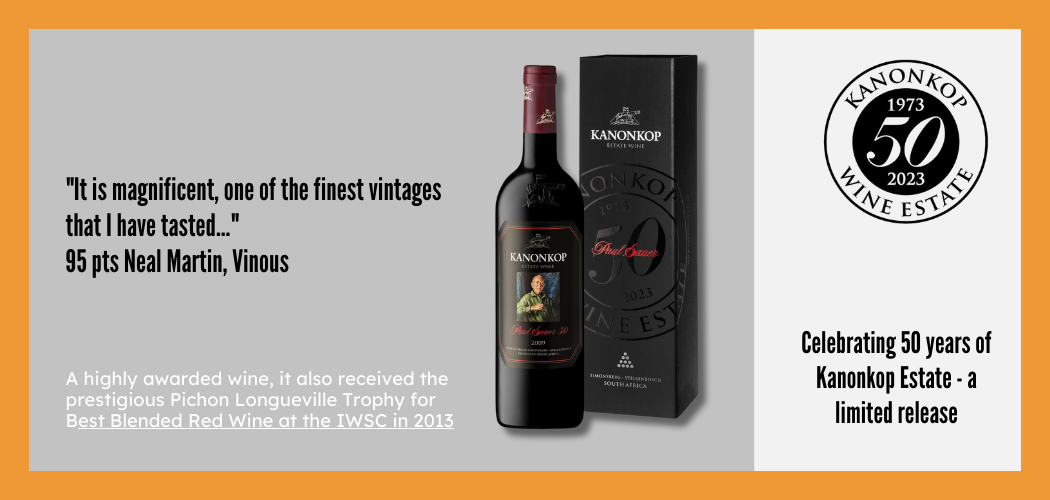Blog, Latest News
A Reputation of Greatness
FIFTY YEARS OF BOTTLED HISTORY
While 50 years is just a blink in the eye of the wine world’s 6 000 year history, the half-century mark is something only a handful of South African wineries can lay claim to. The fundamental reason for this is that until the 1970s, huge corporate wineries like KWV, Distillers, and SFW (Stellenbosch Farmers Winery) controlled the industry and owned a wide range of wine brands created from grapes and wines they sourced from Cape wine farms.
Kanonkop’s decision to make its first wines under an own 1973 vintage label – Cabernet Sauvignon and Pinotage – has an interesting background.
Since the 1940s, legendary founder Paul Sauer oversaw Kanonkop’s winemaking. In 1969 a young winemaker named Jan Boland Coetzee was employed and was soon becoming known as a focussed and knowledgeable man who planted new vineyards on the farm and made excellent wine. However, SFW still bought these wines to blend into its larger brands, including the ubiquitous Chateau Libertas.
Jan Boland was, though, not only a winemaker but also an incredible rugby player, and was rumoured to join the Springboks for the 1974 British and Irish Lions tour.
Here arrived Jannie Krige, husband to Sauer‘s daughter Marie and father of current proprietors Johann and Paul. “What if Kanonkop released its first wine under its own label?”, he asked. The fact that the winemaker was a national rugby hero would instantly give the Kanonkop brand a profile and exciting back-story.
In 1973, Jannie got Paul Sauer‘s blessing to launch two Kanonkop wines in time for Jan’s 1974 Springbok debut against the Lions. The rest, of course, is history.
South Africa’s most famous and critically acclaimed red wine producer was founded on those early bottlings’ exceptional quality. Since that 1973 vintage, winemakers Beyers Truter and Abrie Beeslaar have continued Jan’s dedication to wine quality, each having played a role in elevating the brand to the top echelons of the country’s wine offerings.
Ancestral Home of Pinotage Greatness
In 1925, famed oenologist Abraham Izak Perold crossed Pinot Noir with Hermitage (Cinsaut) to create Pinotage, arguably South Africa’s most famous wine and one for which Kanonkop has gained especial acclaim. Kanonkop’s excellent Simonsberg terroir has produced world-class Pinotage, but the estate’s relationship with the grape variety runs deeper.
Paul Sauer graduated from Elsenburg Agriculture College in 1919 under the tutorship of the very same Abraham Izak Perold, the “father” of Pinotage. Sauer‘s lifelong friendship with Perold, who assisted him with Kanonkop’s viticulture at times, is seen as one of the reasons for the variety to find its roots on Kanonkop. The first plantings were done in the 1940’s, and today the oldest vineyard is the 1953 “Black Label” Pinotage block.
When the first commercial Pinotage was released, the Lanzerac 1959, a substantial amount of Kanonkop grapes were present in the final pioneering product.
However, no serious Pinotage discussion excludes Kanonkop, particularly thanks to Beyers Truter, winemaker from 1981 to 2003. Beyers’ love of the vine and its wines, as well as his crusade to have it recognised as a quality South African red wine, is largely responsible for this.
“Yes, sure, I had something to prove with Pinotage. Remember, half of Kanonkop was planted to Pinotage when I worked there (it still is), but in the late 1980s and early 1990s it was sort of the black sheep of the South Africa wine industry. Wine critics and wine boffins looked down on it, as if it was inferior. However, I knew Pinotage can make great wine, seeing as I was spending half of all my work in the vineyard and in the cellar on Pinotage.” – Beyers Truter
Beyers believed that new 225-litre French oak barrels could transform Pinotage into wonderful, extraordinary wines, so he pushed for more barrels to produce classy and elegant wines, truly South African and truly Kanonkop.
The results showed in 1991, when Beyers received the Robert Mondavi Trophy at the International Wine and Spirits Competition for Best Winemaker in the World for the Kanonkop Pinotage 1989.
Beyers remembers: “I just wish the award was for Wine of the Year and not for the Winemaker, because the best thing about it all – for me – was the accolade going to Pinotage from Kanonkop in South Africa. It was a great moment for Pinotage and the farm, and the country’s wine reputation in general.”
Abrie Beeslaar, Beyers’s Pinotage-loving successor, today maintains Kanonkop’s Pinotage reputation.
“I think the greatness of Kanonkop Pinotage lies in the site where it grows – not too close or far from the ocean, and almost more of a westerly influence than southern. The decomposed granite soils give structure and mid-palate presence with a more dark-fruit expression and visceral palate presence with streamlined tannins.“
Pinotage is an early ripening variety, and the dryland bush-vines are harvested in mid-February. Open-fermenters and manual punch-downs give Pinotage the extraction and skin-juice contact it needs to reveal its myriad flavour compounds.
According to Abrie, a primary indicator of Kanonkop’s suitability for the making of great Pinotage lies in the vintage variation one finds in the wines.
“Every year’s wines show the detail of that season’s climate. This is truly fascinating for the wine-lover, as the label might say Kanonkop Pinotage, but each vintage puts a unique stamp on that year’s wines. But if there are two words I would use to typify this red wine from Kanonkop, it is elegance and grace. Some years the wines taste riper, more upfront fruit. Other years give a wine of more vibrant freshness. But always, there is elegance and the kind of grace one experiences when drinking a wine of true class.”
Browse the range



